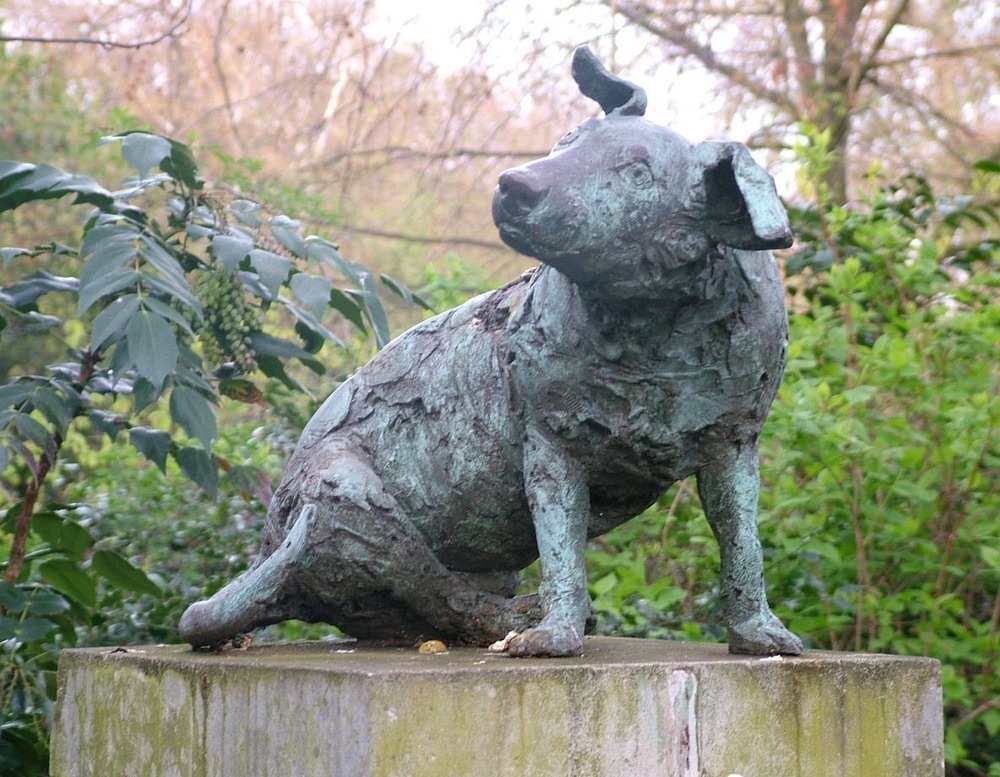【코코타임즈】 우리 평균 수명이 이렇게 길어진 1등 공신이 무얼까?
단연코 의학의 발달이 그 첫째다. 하지만 그런 의학의 발달은 그냥 얻어지지 않았다. 의학실습용으로, 의약품개발용으로 숱한 동물들이 실험용으로 죽어갔기 때문에 가능했던 일. 우리나라에서도 실험용으로 죽어가는 동물들이 매년 늘어나 지금은 연간 300만 마리가 넘는다. 우리들의 생명 연장은 또 다른 생명들을 무참히 앗아야 했던, 어쩌면 '역설적인' 결과물인 셈이다.
그래서 일부 동물실험실에선 이들을 위한 위령제를 올리기도 한다.


 이와 관련, 러시아엔 특별한 동상들이 있다. 의학실험용으로 죽어간 숱한 생명들을 위한 추모동상들.
이와 관련, 러시아엔 특별한 동상들이 있다. 의학실험용으로 죽어간 숱한 생명들을 위한 추모동상들.그 한 예로 노보시비리스크(Novosibirsk, Russia)엔 실험용쥐 동상이 있는데, 우리의 유전자 DNA 이중나선구조를 뜨개질하고 있는 듯한 모습을 하고 있다.
실험실 박사님들처럼 두터운 안경까지 쓰고.
Monument to lab mouse in Novosibirsk, Russia. Photo credit: Irina Gelbukh/Wikimedia
우리 인류의 유전학적 발전이 이들의 희생 위에 세워진, '피비린내나는' 금자탑이란 점을 상징하고 있는 셈.
------
우연히 인터넷 서핑하다 발견했다.
귀한 생명을 빼앗은 사람들의 알량한 짓거리라 치부할 수도 있지만,
다른 한편으론 우리 '인권'과 함께 다른 생명들의 '동물권'을 함께 생각해보게 하는 특별한 제스처일 수도 있겠다.
A statue located in front of the Institute of Cytology and Genetics of the Russian Academy of Sciences in Akademgorodok, near the city of Novosibirsk, pays tribute to the millions of mice sacrificed every year all over the world in the name of science. The statue depicts a mouse in a lab coat and glasses, knitting the DNA double helix. According to the director of the Institute, Nikolai Kolchanov, the Monument to the laboratory mouse “symbolizes gratitude for the animal that humanity has used to study genetics, molecular and physical mechanisms of diseases, as well as for the development of new drugs.” The first stone of the monument was laid in 2012 on the occasion of the 55th anniversary of the founding of the Institute of Cytology and Genetics. The bronze monument was erected the following year. Also in Russia, is this monument.  It’s a monkey, or rather a frilled baboon, also called a Hamadryad. As you can probably see, the animal is pretty odd looking. The males have long hairs, up to a foot long, on their shoulders that hang like a cloak covering their upper body. The baboon is depicted sitting on a pedestal, on which are carved the names of human diseases studied and defeated thanks to the experiments on monkeys. The baboon monument is located on the campus of the Scientific Research Institute of Experimental Pathology and Therapy, in Sukhumi, a city on the coast of the Black Sea. It was erected in 1977 on occasion of the 50th founding anniversary of the monkey nursery at the institute. Sukhumi’s monkey nursery was renowned in Soviet times for training monkeys for space flights. Eight monkey astronauts from the nursery have made it to orbit. The monkey nursery is also renowned for the testing of vaccines for polio, measles, hepatitis, and for new antibiotics and drugs for many other diseases. At its peak the nursery had about 5,000 monkeys, but now it has only around 300 African and Asian monkeys. Several universities and research institutes in countries of the former Soviet Union have monuments dedicated to animals. This monument of a sad-looking dog can be seen at the entrance to the Grodno Medical University, in Belarus. The plaque attached to the large boulder carries the inscription: “The animals for their invaluable contribution to the development of medical science,” or something like that according to Google’s machine translation.
It’s a monkey, or rather a frilled baboon, also called a Hamadryad. As you can probably see, the animal is pretty odd looking. The males have long hairs, up to a foot long, on their shoulders that hang like a cloak covering their upper body. The baboon is depicted sitting on a pedestal, on which are carved the names of human diseases studied and defeated thanks to the experiments on monkeys. The baboon monument is located on the campus of the Scientific Research Institute of Experimental Pathology and Therapy, in Sukhumi, a city on the coast of the Black Sea. It was erected in 1977 on occasion of the 50th founding anniversary of the monkey nursery at the institute. Sukhumi’s monkey nursery was renowned in Soviet times for training monkeys for space flights. Eight monkey astronauts from the nursery have made it to orbit. The monkey nursery is also renowned for the testing of vaccines for polio, measles, hepatitis, and for new antibiotics and drugs for many other diseases. At its peak the nursery had about 5,000 monkeys, but now it has only around 300 African and Asian monkeys. Several universities and research institutes in countries of the former Soviet Union have monuments dedicated to animals. This monument of a sad-looking dog can be seen at the entrance to the Grodno Medical University, in Belarus. The plaque attached to the large boulder carries the inscription: “The animals for their invaluable contribution to the development of medical science,” or something like that according to Google’s machine translation.  Photo credit: turbina.ru In the Russian city of Ufa, known for its number of dental clinics, there is this bronze monument of a dog and a puppy. Dogs are often used in dental research for carrying of studies such as bone healing, dental caries, dental materials, growth studies, oral cancer, etc.
Photo credit: turbina.ru In the Russian city of Ufa, known for its number of dental clinics, there is this bronze monument of a dog and a puppy. Dogs are often used in dental research for carrying of studies such as bone healing, dental caries, dental materials, growth studies, oral cancer, etc.  Photo credit: vsuete.com The following monument and fountain, known as Pavlov’s Dog, is located in the garden of the Institute of Experimental Medicine at the Apothecary island in Saint-Petersburg, Russia.
Photo credit: vsuete.com The following monument and fountain, known as Pavlov’s Dog, is located in the garden of the Institute of Experimental Medicine at the Apothecary island in Saint-Petersburg, Russia.  Photo credit: FotoRand/Wikimedia Ivan Pavlov was a Russian physiologist known primarily for his work in classical conditioning. Pavlov was researching on the physiology of digestion in dogs when he noticed that the dogs would salivate whenever they saw the technician who fed them. Pavlov called the dogs' anticipatory salivation "psychic secretion". After more tests, Pavlov concluded that if a particular stimulus in the dog's surroundings was present when the dog was given food then that stimulus could become associated with food and cause salivation on its own. Pavlov’s works on the physiology of digestion eventually won him the Nobel Prize for Physiology or Medicine in 1904. Pavlov’s experiments with the dogs were a new kind of study at that time. Previously, most experiments with dogs involved vivisection—the practice of performing operations on live animals—which was extremely traumatic and painful for the animals and always resulted in deaths. Pavlov, on the other hand, was interested in observing long-term physiological processes which required keeping the dogs alive and healthy. His laboratory housed a full-scale kennel and his experiments ran for several weeks. Speaking of vivisection, there was once a huge controversy over one particularly gruesome vivisectionconducted at the University College London in the early 20th century. An anonymous brown dog was subjected, over the course of several months, to repeated live surgeries during which the dog was cut open and his pancreas removed, and for the next two months, confined to a cage where it howled and whined in pain. The final act involved exposing the animal’s nerves on the neck and stimulating them with electricity. When two students and anti-vivisectionists exposed the researchers’ cruel methods there was a big uproar leading to lawsuits and riots on London’s streets. Eventually, a memorial was erected at the Battersea Park but it was repeatedly attacked by medical students, who took offence at the memorial’s inscription, forcing authorities to remove the entire statue. Seventy five years later, a new memorial was placed bearing the same inscription as the original, which is: “In Memory of the Brown Terrier Dog Done to Death in the Laboratories of University College in February 1903 after having endured Vivisection extending over more than Two Months and having been handed over from one Vivisector to Another Till Death came to his Release. Also in Memory of the 232 dogs Vivisected at the same place during the year 1902. Men and Women of England how long shall these Things be?”
Photo credit: FotoRand/Wikimedia Ivan Pavlov was a Russian physiologist known primarily for his work in classical conditioning. Pavlov was researching on the physiology of digestion in dogs when he noticed that the dogs would salivate whenever they saw the technician who fed them. Pavlov called the dogs' anticipatory salivation "psychic secretion". After more tests, Pavlov concluded that if a particular stimulus in the dog's surroundings was present when the dog was given food then that stimulus could become associated with food and cause salivation on its own. Pavlov’s works on the physiology of digestion eventually won him the Nobel Prize for Physiology or Medicine in 1904. Pavlov’s experiments with the dogs were a new kind of study at that time. Previously, most experiments with dogs involved vivisection—the practice of performing operations on live animals—which was extremely traumatic and painful for the animals and always resulted in deaths. Pavlov, on the other hand, was interested in observing long-term physiological processes which required keeping the dogs alive and healthy. His laboratory housed a full-scale kennel and his experiments ran for several weeks. Speaking of vivisection, there was once a huge controversy over one particularly gruesome vivisectionconducted at the University College London in the early 20th century. An anonymous brown dog was subjected, over the course of several months, to repeated live surgeries during which the dog was cut open and his pancreas removed, and for the next two months, confined to a cage where it howled and whined in pain. The final act involved exposing the animal’s nerves on the neck and stimulating them with electricity. When two students and anti-vivisectionists exposed the researchers’ cruel methods there was a big uproar leading to lawsuits and riots on London’s streets. Eventually, a memorial was erected at the Battersea Park but it was repeatedly attacked by medical students, who took offence at the memorial’s inscription, forcing authorities to remove the entire statue. Seventy five years later, a new memorial was placed bearing the same inscription as the original, which is: “In Memory of the Brown Terrier Dog Done to Death in the Laboratories of University College in February 1903 after having endured Vivisection extending over more than Two Months and having been handed over from one Vivisector to Another Till Death came to his Release. Also in Memory of the 232 dogs Vivisected at the same place during the year 1902. Men and Women of England how long shall these Things be?”  Memorial to the Brown Dog. Photo credit: Tagishsimon/Wikimedia Everybody knows about Laika, the Soviet space dog who became one of the first animals in space, and the first animal to orbit the Earth. What many are not aware that Laika didn’t have her own memorial until 2008—fifty years after her sacrifice that paved the way for human spaceflights. Laika was a stray dog found on the streets of Moscow, chosen because Soviet scientists thought that Moscow strays are already well endured to conditions of extreme cold and hunger. In preparation for the flight, Laika, along with the other dogs, were kept in tiny cages for weeks on end in order to adapt them to the confines of the tiny cabin of the spacecraft. They were spun around in centrifuges and subjected to simulated noises of the spacecraft. The traumatic experience made many dogs to give up urinating or defecating altogether. When she was finally launched into orbit, a failure in the thermal system caused the cabin to overheat killing Laika within hours of the flight. It wasn’t until 2002 that the true cause of her death was revealed. The Soviet government instead claimed that she died when her oxygen ran out on day six. Although Laika is memorialized in several ways such as featuring on stamps and on the Monument to the Conquerors of Space, positioned behind the cosmonauts, it wasn’t until 2008 that she got her own dedicated memorial. The statue is located at the military research facility in Moscow where staff had been responsible for readying Laika for the flight.
Memorial to the Brown Dog. Photo credit: Tagishsimon/Wikimedia Everybody knows about Laika, the Soviet space dog who became one of the first animals in space, and the first animal to orbit the Earth. What many are not aware that Laika didn’t have her own memorial until 2008—fifty years after her sacrifice that paved the way for human spaceflights. Laika was a stray dog found on the streets of Moscow, chosen because Soviet scientists thought that Moscow strays are already well endured to conditions of extreme cold and hunger. In preparation for the flight, Laika, along with the other dogs, were kept in tiny cages for weeks on end in order to adapt them to the confines of the tiny cabin of the spacecraft. They were spun around in centrifuges and subjected to simulated noises of the spacecraft. The traumatic experience made many dogs to give up urinating or defecating altogether. When she was finally launched into orbit, a failure in the thermal system caused the cabin to overheat killing Laika within hours of the flight. It wasn’t until 2002 that the true cause of her death was revealed. The Soviet government instead claimed that she died when her oxygen ran out on day six. Although Laika is memorialized in several ways such as featuring on stamps and on the Monument to the Conquerors of Space, positioned behind the cosmonauts, it wasn’t until 2008 that she got her own dedicated memorial. The statue is located at the military research facility in Moscow where staff had been responsible for readying Laika for the flight. 









